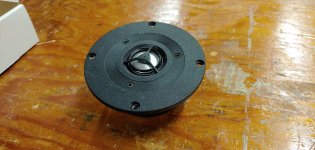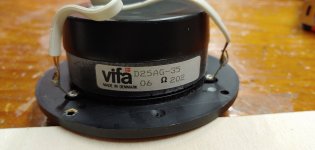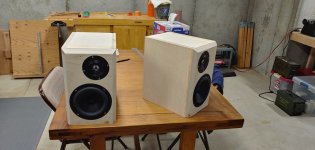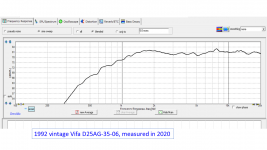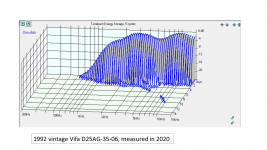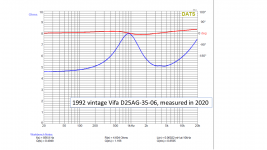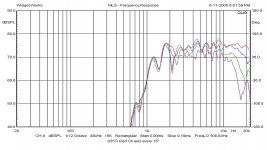As with any driver, if equalized to the same end results, what sonic characteristic difference may you tell, in materials, driver behaviour, etc?
Two tweeters reproducing the same frequencies, equalized the same, everything being the same, would they not also even sound the same?
Dome tweeter vs. a compression driver, is there a leap of progression in utilizing a compression driver instead, or it's all about implementation?
Would a larger voice coil (same throat) naturally equal to a more "natural/present" sound, sounding less boxy or muffled, or what are its benefits?
Two tweeters reproducing the same frequencies, equalized the same, everything being the same, would they not also even sound the same?
Dome tweeter vs. a compression driver, is there a leap of progression in utilizing a compression driver instead, or it's all about implementation?
Would a larger voice coil (same throat) naturally equal to a more "natural/present" sound, sounding less boxy or muffled, or what are its benefits?
If two cars have the same gas mileage, what's the difference between them?
It may take quite a few answers to cover all the things that affect the sound of any driver, EQ'd or not.
If you didn't live over 7000 kms from here, I'd invite you over for a hands on listening session. 🙂
It may take quite a few answers to cover all the things that affect the sound of any driver, EQ'd or not.
If you didn't live over 7000 kms from here, I'd invite you over for a hands on listening session. 🙂
As with any driver, if equalized to the same end results, what sonic characteristic difference may you tell, in materials, driver behaviour, etc?
Two tweeters reproducing the same frequencies, equalized the same, everything being the same, would they not also even sound the same?
Dome tweeter vs. a compression driver, is there a leap of progression in utilizing a compression driver instead, or it's all about implementation?
Would a larger voice coil (same throat) naturally equal to a more "natural/present" sound, sounding less boxy or muffled, or what are its benefits?
Short unswer: no.
I have many speaker systems, and always eq flat in my listening position. Yet each speaker has slightly different sound. Why?
They may be perfectly eq flat on axis, but they will differ of axis, for sure. They will spray the room with different directivity, hence later arriving signal will be slightly different. We do not listen only to direct signal, we hear the room.
When you compare waterfall of various tweeters, that means decay, do you find it similar or different? Each tweeter membrane has different weight, area, hence the decay is different. I have never encountered two tweeters to sound exactly the same. Even of you eq on axis.
Cals example with cars is spot on.
@Cal Weldon
You're right, everything is different, basing my residency off of my username?
@adason
Could not find a way of thumbing up your post, but what an excellent explanation!
We listen to the room, not only the direct signal, I didn't think of this to be quite honest.
Would a different membrane weight/area not be accounted for in driver design to avoid coloration?
Furthermore, the voice coil diameter only seem to dictate the power limit/capability, i.e. no sonic difference.
You're right, everything is different, basing my residency off of my username?
@adason
Could not find a way of thumbing up your post, but what an excellent explanation!
We listen to the room, not only the direct signal, I didn't think of this to be quite honest.
Would a different membrane weight/area not be accounted for in driver design to avoid coloration?
Furthermore, the voice coil diameter only seem to dictate the power limit/capability, i.e. no sonic difference.
I'm not able to track it now, but there has been a little bit of research on this. The differences between tweeters, when equalised, are poorly recognised by an audience. Question 2, what is better, is even more difficult to pinpoint. But of course distortion measurements and polar responses tell us there are differences.
That being said, in the past I had my preferences. Dynaudios were worse than Vifa's (having measured them all, I know why...) and the Vifa D25 alu dome surpassed almost anything short of a Technics leaf tweeter. Thirty years ago... now my ears care less.
That being said, in the past I had my preferences. Dynaudios were worse than Vifa's (having measured them all, I know why...) and the Vifa D25 alu dome surpassed almost anything short of a Technics leaf tweeter. Thirty years ago... now my ears care less.
stmhlm, I based your location from your IP addy, although I do see a lot of those same letters in your nick.
The way I have tested this is to use a mono signal through your eq and just go back and forth. Do it with no other drivers in the system. I think you'll find, whether it's music or just a generator, the differences are not that subtle. Perhaps if you are comparing a paper cone to a paper cone, you might have a more difficult time but the difference between a soft dome, a piezo, a CD, a ribbon and others will all be rather easy to detect.
And yes, I have been bored enough to do that. About a decade ago, you may or may have read about it, I did the Bybee device testing using only my ears and about 20 different drivers. The Bybees were a hot topic then.
The tweeters were something I did later on just for curiosity, so I didn't post about it. I had received some plots in open air so not perfectly accurate but certainly enough to get an idea how to EQ.
https://www.diyaudio.com/community/threads/cals-bybee-experience.184442/
The way I have tested this is to use a mono signal through your eq and just go back and forth. Do it with no other drivers in the system. I think you'll find, whether it's music or just a generator, the differences are not that subtle. Perhaps if you are comparing a paper cone to a paper cone, you might have a more difficult time but the difference between a soft dome, a piezo, a CD, a ribbon and others will all be rather easy to detect.
And yes, I have been bored enough to do that. About a decade ago, you may or may have read about it, I did the Bybee device testing using only my ears and about 20 different drivers. The Bybees were a hot topic then.
The tweeters were something I did later on just for curiosity, so I didn't post about it. I had received some plots in open air so not perfectly accurate but certainly enough to get an idea how to EQ.
https://www.diyaudio.com/community/threads/cals-bybee-experience.184442/
Last edited:
How are you eqing them in the first place?
Eqing for a flat on axis respone?
What about power and off axis responses? those can't be fixed with eq/dsp or anything else but proper implementation.
And what about impulse response, csd etc?
again 2 different products will never be identical.
Although this was already pointed out above.
Eqing for a flat on axis respone?
What about power and off axis responses? those can't be fixed with eq/dsp or anything else but proper implementation.
And what about impulse response, csd etc?
again 2 different products will never be identical.
Although this was already pointed out above.
Does that research proove that after eq $0.75 tweeter sounds the same as expensive mundorf or raal? I sure would like to see the link to such research. Would save me lots of money.I'm not able to track it now, but there has been a little bit of research on this. The differences between tweeters, when equalised, are poorly recognised by an audience. Question 2, what is better, is even more difficult to pinpoint. But of course distortion measurements and polar responses tell us there are differences.
That being said, in the past I had my preferences. Dynaudios were worse than Vifa's (having measured them all, I know why...) and the Vifa D25 alu dome surpassed almost anything short of a Technics leaf tweeter. Thirty years ago... now my ears care less.
I was simply using the FR graphs a friend had done for me, and positioning the EQ sliders accordingly. I wasn't expecting the world from these results, I was simply curious. The point being is that if the EQing wasn't perfect, that was fine, I was looking to characterize the 'sound' of the tweeters, nothing more. It was on axis only.
I didn't do it with the mids or any other drivers as this wasn't a big deal. Maybe when I retire, I might get curious again.
I didn't do it with the mids or any other drivers as this wasn't a big deal. Maybe when I retire, I might get curious again.
adason, I wouldn't say markbakk said that exactly. Take polars for example, you might see breakup differences there.. and there's more if you go looking.
However for the larger part, EQ makes similar looking/functioning tweeters sound the same.
However for the larger part, EQ makes similar looking/functioning tweeters sound the same.
That being said, in the past I had my preferences. Dynaudios were worse than Vifa's (having measured them all, I know why...) and the Vifa D25 alu dome surpassed almost anything short of a Technics leaf tweeter.
I also always thought they sounded nice. very natural. These tweeters are 28 years old, and I removed them from an old 3-way project I built in 1992. In 2020, I built a new 2-way monitor and re-used them. SB midwoofer paired up nicely with them.
To the original post, Yes I believe I can hear the difference even when the two tweeters have very similar off-axis radiation patterns, and have been eq'd to be the same. But it is a very subtle difference. Not something I immediately pick up on.
Attachments
Wow, second on the Vifa D25AG having magic. I used them back then too. One day I decided to snip off the shield (don't waste your time), then later I dented the domes while moving them.. I recall being frustrated with the Vifa D27TG because I missed the sound of the D25.
I'd also heard that they had a resonance at 11k, at the time I didn't look into. I imagine that it contributed to the 'aluminium sound', ie the dome sounded a little like foil.. but not in a bad way.
I'd also heard that they had a resonance at 11k, at the time I didn't look into. I imagine that it contributed to the 'aluminium sound', ie the dome sounded a little like foil.. but not in a bad way.
The best metal domes are ever heard are a blast from the past. About 40 years ago, Coral had the H-22. When comparing it with the Philips and other soft domes of the time, hands down they were nicer. Problem was they were 3 times the price. Rarely see them anymore.
Attachments
For old time‘s sake, the Vifa datasheet in 1992 included a CSD plot. Some disturbance for sure, but pretty clean (way better than the newer D27 soft dome).
BOT, a tweeter has to be selected for it‘s task. So telling the difference between two tweeters probably isn‘t that relevant as long as the objectives aren’t clear.
BOT, a tweeter has to be selected for it‘s task. So telling the difference between two tweeters probably isn‘t that relevant as long as the objectives aren’t clear.
Attachments
Lol, yes I remember that wonky X-axis (Vifa's plotting). Seems I wasn't right about the 11k resonance but there's plenty there that's interesting.
Last edited:
Here are some measurements I took in 2020. Regarding the toneburst, I have no idea why I plotted only to 15 kHz. It was probably not intentional, just an oversight. The frequency response was taken in a foam-board mockup box similar in shape to post #11. Based on these measurements (and the harmonic distortion results), I decided to re-use this tweeter.
Not bad performance from a tweeter which had been in daily use for 28 years ! The 3-way system was the main sound system for my household audio-visual-TV-music needs.
j.
Not bad performance from a tweeter which had been in daily use for 28 years ! The 3-way system was the main sound system for my household audio-visual-TV-music needs.
j.
Attachments
I had to make up for some claim of mine earlier in this thread, here you all go. And yes, it is in German. 😊
- Home
- Loudspeakers
- Multi-Way
- Can you really tell the difference between two tweeters?
